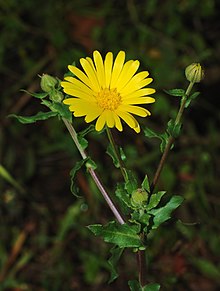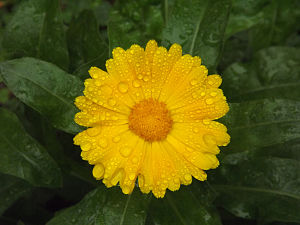| Calendula | |
|---|---|

| |
| field marigold (Calendula arvensis) | |
| Scientific classification | |
| Kingdom: | Plantae |
| Clade: | Tracheophytes |
| Clade: | Angiosperms |
| Clade: | Eudicots |
| Clade: | Asterids |
| Order: | Asterales |
| Family: | Asteraceae |
| Subfamily: | Asteroideae |
| Tribe: | Calenduleae |
| Genus: | Calendula L. |
| Species | |
|
See text | |
| Synonyms | |
| |
Calendula (/kəˈlɛndjuːlə/) is a genus of about 15–20 species of annual and perennial herbaceous plants in the daisy family, Asteraceae that are often known as marigolds. They are native to Europe, North Africa, Macaronesia and West Asia, and have their center of diversity in the Mediterranean Region. Other plants known as marigolds include corn marigold, desert marigold, marsh marigold, and plants of the genus Tagetes.
The genus name Calendula is a modern Latin diminutive of calendae, meaning "little calendar", "little clock" or possibly "little weather-glass". The common name "marigold", a contraction of "Mary's gold" refers to the Virgin Mary. The most commonly cultivated and used member of the genus is Calendula officinalis, the pot marigold. Popular herbal and cosmetic products named "Calendula" invariably derive from C. officinalis.
Uses
History
Calendula was not a major medicinal herb but it was used in historic times for headaches, red eye, fever and toothaches. As late as the 17th century Nicholas Culpeper claimed Calendula benefited the heart, but it was not considered an especially efficacious medicine.
In historic times Calendula was more often used for magical purposes than medicinal ones. One 16th-century potion containing Calendula claimed to reveal fairies. An unmarried woman with two suitors would take a blend of powdered Calendula, marjoram, wormwood and thyme simmered in honey and white wine used as an ointment in a ritual to reveal her true match.
Ancient Romans and Greeks used the golden Calendula in many rituals and ceremonies, sometimes wearing crowns or garlands made from the flowers. One of its nicknames is "Mary's Gold", referring to the flowers' use in early Christian events in some countries. Calendula flowers are sacred flowers in India and have been used to decorate the statues of Hindu deities since early times.
The most common use in historic times was culinary, however, and the plant was used for both its color and its flavor. They were used for dumplings, wine, oatmeal and puddings. In English cuisine Calendula were often cooked in the same pot with spinach, or used to flavor stewed birds. According to sixteenth-century Englishman John Gerard, every proper soup of Dutch cuisine in his era would include Calendula petals.
Culinary
Also known as "poor man's saffron," the petals are edible and can be used fresh in salads or dried and used to color cheese or as a substitute for saffron. Calendulas have a mildly sweet taste that is slightly bitter, and as it dries these flavors become more intense. It can be used to add color to soups, stews, poultry dishes, custards and liquors.
The common name for Calendula officinalis in Britain is 'pot-marigold,' named so because of its use in broths and soups.
Dyes
Dye can be extracted from the flower and produce shades of honey, gold, orange, light brown, and vibrant yellow.
Chemistry
The flowers of C. officinalis contain flavonol glycosides, triterpene oligoglycosides, oleanane-type triterpene glycosides, saponins, and a sesquiterpene glucoside.
Pharmacological effects
Calendula officinalis oil is still used medicinally as an anti-inflammatory and a remedy for healing wounds. Calendula ointments are skin products available for use on minor cuts, burns, and skin irritation; though evidence of their effectiveness is weak.
Plant pharmacological studies have suggested that Calendula extracts have antiviral, antigenotoxic, and anti-inflammatory properties in vitro. In herbalism, Calendula in suspension or in tincture is used topically for treating acne, reducing inflammation, controlling bleeding, and soothing irritated tissue. Limited evidence indicates Calendula cream or ointment is effective in treating radiation dermatitis. Topical application of C. officinalis ointment has helped to prevent dermatitis and pain; thus reducing the incidence rate of skipped radiation treatments in randomized trials.
Calendula has been used traditionally for abdominal cramps and constipation. In experiments with rabbit jejunum, the aqueous-ethanol extract of C. officinalis flowers was shown to have both spasmolytic and spasmogenic effects, thus providing a scientific rationale for this traditional use. An aqueous extract of C. officinalis obtained by a novel extraction method has demonstrated antitumor (cytotoxic) activity and immunomodulatory properties (lymphocyte activation) in vitro, as well as antitumor activity in mice.
Calendula plants are known to cause allergic reactions in susceptible individuals, and should be avoided during pregnancy.
Diversity


Species include:
- Calendula arvensis (Vaill.) L. – field marigold, wild marigold
- Calendula denticulata Schousb. ex Willd.
- Calendula eckerleinii Ohle
- Calendula incana Willd.
- Calendula incana subsp. algarbiensis (Boiss.) Ohle
- Calendula incana subsp. maderensis (DC.) Ohle – Madeiran marigold
- Calendula incana subsp. maritima (Guss.) Ohle – sea marigold
- Calendula incana subsp. microphylla (Lange) Ohle
- Calendula lanzae Maire
- Calendula maritima Guss. - sea marigold
- Calendula maroccana (Ball) Ball
- Calendula maroccana subsp. maroccana
- Calendula maroccana subsp. murbeckii (Lanza) Ohle
- Calendula meuselii Ohle
- Calendula officinalis L. – pot marigold, garden marigold, ruddles, Scottish marigold
- Calendula palaestina Boiss.
- Calendula stellata Cav.
- Calendula suffruticosa Vahl
- Calendula suffruticosa subsp. balansae (Boiss. & Reut.) Ohle
- Calendula suffruticosa subsp. boissieri Lanza
- Calendula suffruticosa subsp. fulgida (Raf.) Guadagno
- Calendula suffruticosa subsp. lusitanica (Boiss.) Ohle
- Calendula suffruticosa subsp. maritima (Guss.) Meikle
- Calendula suffruticosa subsp. monardii (Boiss. & Reut.) Ohle
- Calendula suffruticosa subsp. tomentosa Murb.
- Calendula tripterocarpa Rupr.
Gallery
-
 Calendula arvensis
Calendula arvensis
-
 Calendula suffruticosa subsp. fulgida
Calendula suffruticosa subsp. fulgida
-
 Calendula officinalis from Flora von Deutschland, Österreich und der Schweiz, by Thomé, 1885
Calendula officinalis from Flora von Deutschland, Österreich und der Schweiz, by Thomé, 1885
-
 Calendula officinalis
Calendula officinalis
-
 The endangered Calendula maritima
The endangered Calendula maritima
-
 Calendula arvensis seeds
Calendula arvensis seeds
-
 Calendula arvensis in full bloom
Calendula arvensis in full bloom
References
- Calendula L. Archived 2024-03-03 at the Wayback Machine Plants of the World Online. Retrieved 29 September 2023.
- Sunset Western Garden Book, 1995:606–607
- Calendula. Archived 2015-04-02 at the Wayback Machine Flora of China.
- Stace, C. A. (2010). New Flora of the British Isles (Third ed.). Cambridge: Cambridge University Press. ISBN 9780521707725.
- "Calendula L. | Plants of the World Online | Kew Science". Plants of the World Online. Retrieved 10 November 2024.
- ^ Shorter Oxford English Dictionary (6th ed.). United Kingdom: Oxford University Press. 2007. p. 3804. ISBN 978-0199206872.
- ^ Rodale's Illustrated Encyclopedia of Herbs
- Doctor, Vikram (20 October 2017). "Marigold: The Mexican flower that has become a part of Indian festivals". Economic Times Blog. Archived from the original on 1 May 2020. Retrieved 2 April 2020.
- "Calendula Uses (Poor Man's Saffron) - Soothing Spices". 2020-11-03. Retrieved 2022-04-26.
- Spotlight on Marigold. Archived 2011-05-18 at the Wayback Machine The Complete Herbal - Herbs and Herbal Remedies.
- "Calendula Flowers". specialtyproduce.com. Archived from the original on 2022-10-19. Retrieved 2022-04-26.
- MACHT, DAVID I. (1955). "Calendula or Marigold in Medical History and in Shakespeare". Bulletin of the History of Medicine. 29 (6): 491–502. ISSN 0007-5140. JSTOR 44446726. PMID 13276712.
- McLaughlin, Chris (July 2020). "Homemade Calendula Dye". Mother Earth News. Retrieved 2021-03-03.
- Ukiya, M., et al. (2006). Anti-inflammatory, anti-tumor-promoting, and cytotoxic activities of constituents of pot marigold (Calendula officinalis) flowers. J Nat Prod. 69 1692-96.
- Yoshikawa, M., et al. (2001). Medicinal flowers. III. Marigold.(1): hypoglycemic, gastric emptying inhibitory, and gastroprotective principles and new oleanane-type triterpene oligolycosides, calendasaponins A, B, C, and D, from Egyptian Calendula officinalis. Chem Pharm Bull. 49 863-70.
- Okoh, O. O., et al. (2008). The effects of drying on the chemical components of essential oils of Calendula officinalis L. Archived 2013-10-29 at the Wayback Machine African Journal of Biotechnology 7(10) 1500-02.
- ^ Calendula ointment Archived 2015-04-19 at the Wayback Machine entry in the public domain NCI Dictionary of Cancer Terms
- Matthew J. Leach (2008). "Calendula officinalis and Wound Healing: A Systematic Review". Wounds. 20 (8). Archived from the original on 2019-04-04. Retrieved 2019-03-19.
- ^ Jimenez-Medina, E., et al. (2006). A new extract of the plant Calendula officinalis produces a dual in vitro effect: cytotoxic anti-tumor activity and lymphocyte activation. BMC Cancer. 6:6.
- Duran, V; Matic, M; Jovanovć, M; Mimica, N; Gajinov, Z; Poljacki, M; Boza, P (2005). "Results of the clinical examination of an ointment with marigold (Calendula officinalis) extract in the treatment of venous leg ulcers". Int J Tissue React. 27 (3): 101–6. PMID 16372475.
- ^ Pommier, P., et al. (2004). Phase III randomized trial of Calendula officinalis compared with trolamine for the prevention of acute dermatitis during irradiation for breast cancer. Archived 2015-07-26 at the Wayback Machine J Clin Oncol. 22(8) 1447-53.
- McQuestion, M. (2006). Evidence-based skin care management in radiation therapy. Semin Oncol Nurs. 22 163-73.
- Bolderston, A., et al. (2006). The prevention and management of acute skin reactions related to radiation therapy: a systematic review and practice guideline. Support Care Cancer. 14 802-17
- ^ Bashir S, Janbaz KH, Jabeen Q et al. (2006). Studies on spasmogenic and spasmolytic activities of Calendula officinalis flowers. Phytother Res. 20:906-910.
- ^ "About Herbs, Botanicals & Other Products: Calendula". Memorial Sloan-Kettering Cancer Center. 19 June 2023. Archived from the original on 4 April 2012. Retrieved 25 February 2012.
- Reider, N; Komericki, P; Hausen, BM; Fritsch, P; Aberer, W (2001). "The seamy side of natural medicines: Contact sensitization to arnica (Arnica montana L.) and marigold (Calendula officinalisL.)". Contact Dermatitis. 45 (5): 269–72. doi:10.1034/j.1600-0536.2001.450503.x. PMID 11722485. S2CID 38613828.
- Flann, Christina (ed.). "Search Calendula". Global Compositae Database (GCD). Archived from the original on 24 September 2020. Retrieved 31 March 2011.
External links
- Flora Europaea: Calendula
- Germplasm Resources Information Network: Calendula
- Botanical.com: Calendula
| Taxon identifiers | |
|---|---|
| Calendula |
|